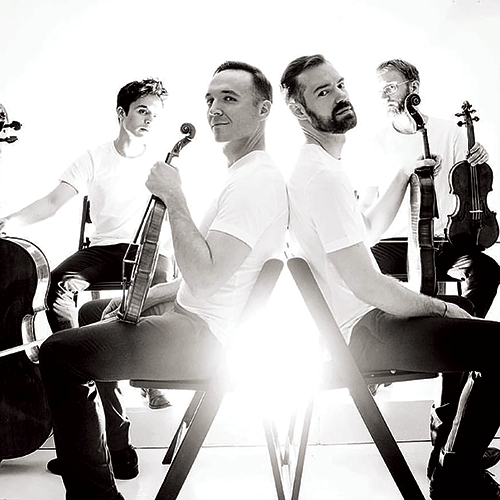JACK Quartet wraps homegrown series with humor and mysticism

The JACK Quartet performed the final program in its Soundscape America series Saturday night at Miller Theatre.
It’s a rare concert program that makes John Zorn sound like the old fuddy-duddy in the room, but that’s what happened Saturday night in the final installment of “Soundscape America,” the JACK Quartet’s adventurous two-concert series at Miller Theatre.
To be fair, Zorn’s 2004 work Necronomicon had plenty of the fresh and fierce sounds this composer is known for, but it was written for four string players sitting in a semicircle, bowing and plucking their instruments in the usual way. How old-fashioned is that?
Before Zorn’s piece, which concluded the program, the JACK players—violinists Christopher Otto and Austin Wulliman, violist John Pickford Richards, and cellist Jay Campbell—had served up platefuls of Gloria Coates’ signature queasy glissandos in her String Quartet No. 8, played to each other across the full width of the stage in Marcos Balter’s gossamer Chambers, and acted like cartoon characters in Natacha Diels’s Nightmare for JACK (a ballet).
Even Ruth Crawford Seeger’s String Quartet 1931 astonished, not by any choreography or special effects, but by the audacity of its musical concepts. Hearing the piece’s radical dissociation and layering of parts—techniques associated with mid- and late-20th century music—had one rubbing one’s eyes and looking again at the year of composition in the title.
What Saturday’s program, along with its counterpart last Thursday, demonstrated is that the one thing that makes American music American is that’s there’s no one thing. One could cite energy and optimism, but the events of 9/11 are now part of American experience too, and it was sympathy for the victims of that dark day that moved Coates to compose her quartet in 2001-02, when most artists were still too stunned to address the subject.
As played with superb control and balancing sensitivity by JACK, Coates’s slow glissandos gathered like tendrils of smoke in the first movement, “On Wings of Sound,” then gained energy in “In Falling Timbers Buried,” whose title comes from an Emily Dickinson poem about a man buried in a mine collapse and the efforts to save him. The last movement, “Prayer,” subtly evoked hymns at a camp meeting with the primitive sound of parallel fifths.
Lighting designer Nick Kolin lit the stage’s back wall sky blue for Coates’s first movement and red for the second, both understandable choices, but going to black for the “Prayer” seemed to contradict the note of hope and faith in the music. Throughout the evening, Kolin’s lighting choices were appropriate and not too intrusive, but much of the time, with playing of the caliber of JACK’s, one questioned the need for any lighting effects at all.
In Berlin on a Guggenheim Fellowship in 1931, Ruth Crawford, as she was known then, first attempted to compose a symphony, then redirected her ideas into a string quartet, which proved the ideal medium for them. Hearing this music Saturday, one was amazed at the poise and self-assurance of the rookie composer as she all but reinvented this tradition-encrusted genre.
In a good performance of the piece, the four independent parts, each well-executed, can sound like four individuals amusingly talking past each other. JACK’s achievement on Saturday was to bring the voices together in a single animated, even rhapsodic statement in the first movement, followed by a cockeyed Mendelssohnian scherzo, an Andante in long notes on an undulating crescendo, and a mordant, scurrying finale.
Soon after composing this quartet, Crawford returned to the United States, married her former composition teacher Charles Seeger, and devoted most of the rest of her illness-shortened life (she died of cancer in 1953, at age 52) to family and political causes. To this day, her quartet is heard far less often than those of Elliott Carter, of which it is a masterful forerunner.
Natacha Diels has composed several “nightmares,” surrealistic pieces with a dark side, real or implied. Her score for Nightmare for JACK (a ballet) is indeed full of choreographic instructions for the (mostly) seated players, resulting in a droll parody of classical-music performance conventions, evoking the Warner Brothers cartoons of old.
Instruments were yanked up and set down with military precision, furious glances exchanged, toy percussion instruments played with exaggerated seriousness. A player leaped up to frantically conduct one section with a toy mallet. It was all accompanied by electronics-enhanced honks, knocks and quirky microphrases in the manner of the classic cartoon composer Carl Stalling (whose music Diels has quoted in previous works). The musicians carried it off with precise ensemble and impeccable comic timing.
For Balter’s piece, which the Brazilian-born composer described as “a three-part snapshot of my compositional personality,” the players stood (all but cellist Campbell, of course) far apart on the stage, filling the space among them with a pianissimo tissue of breeze, populated by peeping birds. Moving into another “chamber” of the composer’s mind, the atmosphere thickened and angry birds seemed to replace the serene ones. The last movement offered a bit of swaying melody over a pizzicato “guitar,” gently evoking Balter’s birthplace as this spatially-wide yet intimate piece came to a close.
In dramatic contrast, Zorn’s Necromonicon—the title comes from the vintage science-fiction writer H.P. Lovecraft—evoked mysticism and the occult in their most lurid guises, including hard-driving rock in the opening movement “Conjurations,” a Hebraic cello melody with persistent noisy interruptions in “The Magus,” a blaze of fast-fingered virtuosity in “Thought-Forms,” a rich slow vibrato suggesting primeval depths in “Incunabula,” and raw Bartókian energy to invoke the mythical sexual demon “Asmodeus.”
And so this well-planned and superbly performed two-concert series of American string quartets came to an end. Two more, anyone?
The next music presentation at Miller Theatre is harpsichordist Mahan Esfahani in Bach’s Goldberg Variations 8 p.m. Thursday. The theatre’s “Composer Portrait” series will feature works by Marcos Balter 8 p.m. Nov. 16. millertheatre.com; 212-854-7799.






